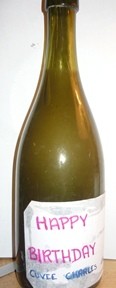
1947 Saumur Cuvée Charles,
With what we thought was a magnificent gesture on the occasion of Sheila’s birthday, we shared this vintage bottle of wine provided by Robert and Jeanette Guyons, our very special friends and neighbours ‘en face’, being the former owners and winemakers here at Le Clos des Guyons or Le Domaine des Guyons as it then was.
This was the last bottle of 1947 that Robert had in his wine cellar which was made by his father, Charles Guyon, in what is now, our wine chais after being released from a prisoner of war camp in Germany where he had been incarcerated since 1940. In fact we found about a dozen bottles in our caves, hidden under sand, when we were helping Robert to move his things. Of course there was no label other than the one which was originally tied around the neck but Robert (or more probably, Jeanette)! had written “Happy Birthday”, and Cuvée Charles 1947″. A nice touch I thought. Were the wine to be bottled now it would probably be as Saumur Blanc and in 1947 would have been an Anjou/Saumur as the individual Saumur appellation wasn’t created until later (the Anjou/Saumur appellation dates back to 1936). After tasting I am not sure where it would fit now as it has developed such individuality that it would probably defy all the “typicity” requirements of any of our local appellations.

“Well” at the base of a 1947 Saumur wine bottle.
It is very difficult for people who did not live in occupied Europe to grasp what it was actually like during that period. Robert, who was a young boy at the time, tells us of the Germans arriving into the village of Le Puy-Notre-Dame and taking over the school as their headquarters, how the village was almost empty of young men as they were either in England or in German POW camps and how the situation changed after the SS. took over a couple of years later, when Resistance arms were discovered in one of the many caves in the village. How the owner of the caves was deported, later to die in a Concentration Camp, (Le Place de la Paleine was later renamed in his honour, Le Place de Jules Raimbault), and how the Germans disappeared overnight and the village was formally liberated by a Gendarme, on a bike, with the tricolour attached, pedalling from Doué la Fontaine. Couple experiences like thatwith with memories of the devastation caused by five years of war and the fact that Le Puy-Notre-Dame is not that far from Oradour-sur-Glane where women and children were burnt alive in a church because the Resistance had abducted a German Panzer leader and, a similar instance occuring just the other side of Tours, that is why, for someone of Robert’s generation, opening a bottle of 1947 wine isn’t just about the wine itself but about celebrating the end of one of the worst, most horrific periods in human history. To add a personal opinion it probably also explains the difference in attitudes towards the European Union in the UK and on Continental Europe. No matter how much they may moan about the EU. In all our 12 years in France I have never met any average French person who would really want to go back to a time of competing nation states where war was, to quote Clausewitz, merely “the continuance of diplomacy by other means”. The photo below was taken in 1970 and shows Charles and his wife Aline a woman of very strong character who, through sheer will power, kept the vineyard going by herself, despite all the tribulations of the years of occupation. She only died a couple of years ago, at 92 years years of age.

Monsieur et Madame Charles Guyons and their pet dog, Louky
Anyway, enough of that – back to the wine! In fact, we were not sure how the wine would taste once this old heavy bottle was uncorked, (don’t know whether you can make out the “well” but it is much, much deeper than in modern bottles, having a depth or around 7cms).but the anticipation was well worth what was to come, not to mention the privileged feeling of sharing this together. Robert pulled the 1947 cork which was well intact after all these years and we were not disappointed. 1947 is one of the great years for French wine, a reference year. The Chenin grape is one which is full of complexity and is capable of developing many facets as it develops and this was a great example. It had lost the lemony, white fruity tang of its youth and developed a multi-layered, minerally feel which reflected the limestone based terroir on which it was grown. The wine had undergone the sort of controlled oxidation that you find in sherry or in very old white Rioja which has spent up-to 40 years in old oak, giving a sherry like layer to go with the rest of the complexity in the mouth which it filled with a sumptuousness which is difficult to explain. The length, whilst prolonged was a little short given the power of the wine itself but perhaps this is only to be expected in a wine approaching its 65th. birthday. We shared a toast and chinked our glasses to Charles Guyons thanking him for the pleasure he had given to us all at that moment, but without doubt it held more emotion for Robert and there was a glint of tears in his eyes as, I’ve no doubt, the years rolled away and the memories cascaded in.
It was a truly memorable occasion which enhanced the pleasure of living in an historic wine village like Le Puy-Notre-Dame here in the Loire.
à votre!
Brian
Vacation properties and wine tours tours of the Loire Valley.




